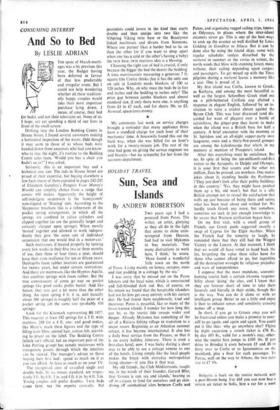CONSUMING INTEREST
And So to Bed
By LESLIE ADRIAN
THE spate of March marri- ages was a bit previous this year, the Budget having been deferred in favour of that less predictable and irregular event. But I could not help wondering whether all these tradition- ally happy couples would take their most important purchase lying down. I mean, of course, their bed (or beds), and not their television set. None of us, I hope, are yet spending a third of our lives in front of the small screen.
Drifting into the London Bedding Centre in Sloane Street, I found several customers making a horizontal inspection of the wares. Odd though it may seem to those of us whose beds were handed down from ancestors who had you-know- who to stay the night, it's routine to the Bedding Centre sales team. `Would you buy a chair you hadn't sat in?' I was asked.
Seriously, this is an important buy and a technical one, too. The lads in Sloane Street are proud of their expertise, but buying elsewhere a few facts (most of them capsuled in pages 242-245 of Elizabeth Gundrey's Penguin Your Money's Worth) can simplify choice from a range that covers 450 makes. Apparently the height, of self-indulgent suspension is the 'honeycomb' non-clipped or `floating' unit. According to the Sleepeezee brochure this is a refinement of the pocket spring arrangement, in which all the springs are confined in calico cylinders and clipped together (as are the generally larger and certainly cheaper open springs). When merely `nested' together and allowed to work indepen- dently they give 'the same sort of individual suspension that one would find in a motor-car.'
Such mattresses, if treated properly by turning every few weeks in their first two or three months of use, then three or four times a year, should keep their even resilience for ten or fifteen years. Dunlopillo foam rubber interiors are guaranteed for twenty years, but under certain restrictions. And there are mattresses, like the Hypnos Aquila, that combine springs with foam rubber. But the true connoisseurs of coma go nap on pocket springs like good cooks prefer butter. And like butter, they cost just a bit more than the other thing. An open spring 4 ft. 6 in. unit (usually about 300 springs) is roughly half the price of a pocket spring job the same size (probably 450 springs).
Look for the Kitemark representing BS 1877. This requires at least 192 springs for a 3 ft. wide mattress, 288 for a 4 ft. one; and good makes, like Myer's, mark these figures and the type of filling (coir fibre, animal hair, cotton felt, accord- ing to price) on the label. The Bedding Centre (which isn't official, but an important part of the John Perring group) has sample mattresses with transparent panels through which the interiors can be viewed. The manager's advice to those buying their. first bed: spend as much on it as you can afford. At least as much as on your TV.
The recognised sizes of so-called single and double beds, by no means standard, are respec- tively 3 ft. by 6 ft. 3 in. and 4 ft. 6 in. by 6 ft. 3 in. Young couples still prefer doubles. Twin beds come later, say the experts cynically. But pessimists could invest in the kind that starts double and then unzips into two like the ViSpring Viking twin base or the Beautyrest linked mattresses and divans from Simmons. Where one partner likes a harder bed to lie on than the other (or if you want to sleep apart when one has a cold or the other's having a baby) the twin base, twin mattress idea is a blessing.
Choosing the right size of bed is crucial, if only because the bigger the bed the dearer the bedding. A lett° matrimoniale measuring a generous 7 ft. square (the Centre thinks that it has the only one on sale in London) needs blankets of 100 to 120 inches. Why, oh why must the beds be in feet and inches and the bedding in inches only? The price gap between jumbo blankets and almost standard size, if only there were one, is anything from £4 to £7 each, and for sheets 30s. to £3. As usual, space costs money.


































 Previous page
Previous page